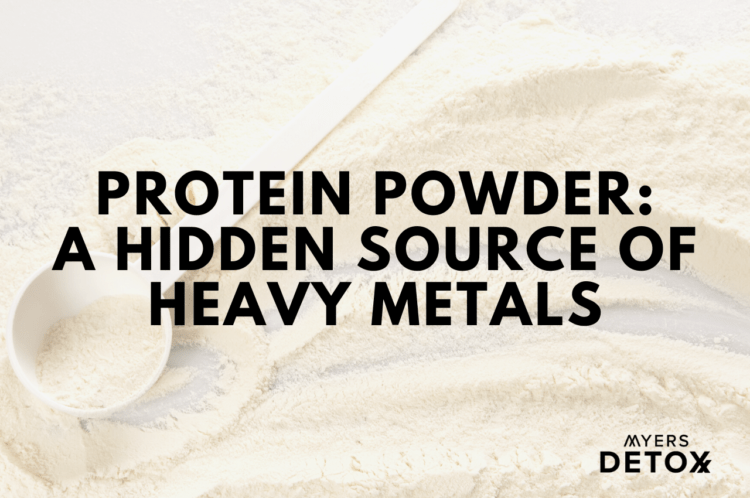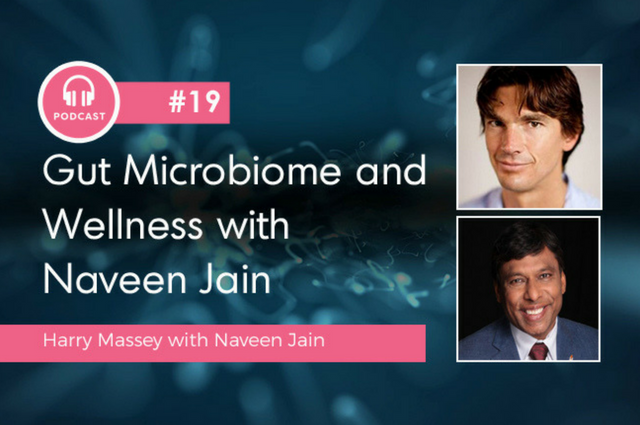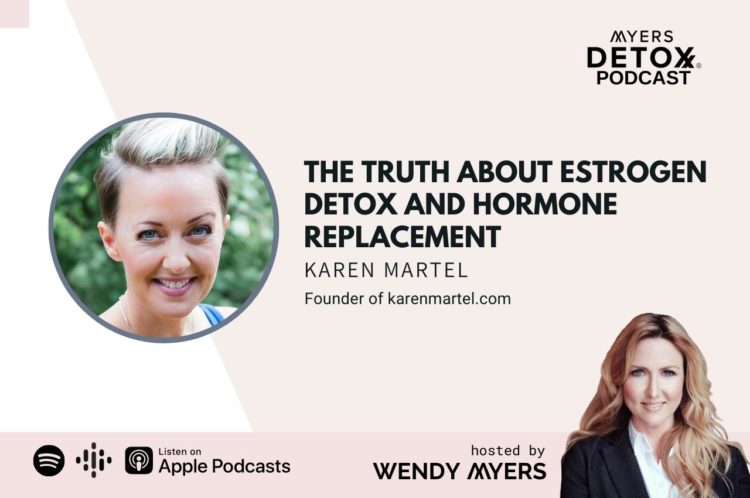Protein Powder: A Hidden Source of Heavy Metals

Are there heavy metals hiding in your protein powder? Most likely, the answer is yes. This popular food supplement imparts many health benefits, but the dangers of heavy metals cannot, and should not be ignored.
In this article, you’ll learn:
- About protein powders and heavy metals
- Which heavy metals are hiding in your protein powders
- The harmful effects of heavy metals
- What you can do to protect yourself from heavy metal toxicity
Protein Powders and Heavy Metals
Protein powder is one of the most popular supplements used by people in the US, making up over 4 billion dollars in sales annually.
Why is this supplement so popular? Because it’s an incredibly convenient form of protein that can be used to support common health goals, like increasing muscle mass and weight loss, while catering to most Americans’ hectic lifestyle.
However, the problem with protein powders is that these products may contain several contaminants that the FDA (Food and Drug Administration) doesn’t have to regulate.
For example, when the Clean Label Project™ (a national nonprofit with the mission to bring truth and transparency to food and consumer product labeling) tested protein powder supplements, they found a myriad of contaminants in some of the most popular brands.
More specifically, they tested over 60 brands and 134 products and found positive levels of arsenic, cadmium, lead, and mercury, along with other contaminants like pesticides and BPA.
As a consumer, you most likely assume that the food products you buy are safe. But the truth is there are contaminants in most (if not all) of the foods you purchase. That’s why food isn’t labeled “free of heavy metals” — the regulation just isn’t there at this point.
What’s more, dietary supplements, in general, don’t require FDA approval for marketing claims. This results in misleading labeling such as “all-natural” in big, bold letters plastered across a protein powder canister that’s loaded with heavy metals.
So, where do these contaminants come from? The Clean Label Project™ suggests that many of the heavy metals come from the soil that the ingredients in protein powder are grown in. For example, the cocoa plant has the ability to absorb high levels of the heavy metal cadmium from the soil. Therefore, chocolate protein powders may be worse offenders than vanilla.
Interestingly, according to The Clean Label Project™, plant-based powders, in general, tend to be higher in heavy metals than whey protein[1].
Does this mean you need to give up protein powder altogether? Not quite.
There are, however, certain measures you can take to make sure you’re buying powders that are lower in heavy metals while also supporting your body in clearing heavy metals from your system.
Before I jump into the solution, however, I want to highlight the issues that may surround the heavy metals found in protein powders.
Dangers Of Heavy Metals
Heavy metals have a toxic effect on your body. While low levels of metals are ubiquitous in our environment, when they accumulate in your body, they can have a range of harmful effects on your body’s systems.
They can damage and alter the function of organs like your brain, kidneys, lungs, and liver. What’s more, long term exposure may lead to serious health conditions[2].
The heavy metals found specifically in protein powders, and their potentially dangerous effects include:
Arsenic
Arsenic is a natural component of the earth’s crust and can be found distributed in the environment in the air, water, and soil. Common routes of arsenic exposure include drinking water and contaminated food grown in soil.
This heavy metal is a confirmed carcinogen. The acute effects of high levels of arsenic include vomiting, abdominal pain, and diarrhea. More chronic, long-term effects of arsenic may include skin lesions, pigmentation changes, hyperkeratosis (hard patches of skin).
Other adverse effects may include diabetes, pulmonary disease, and cardiovascular disease[3].
Cadmium
Cadmium can be found in both drinking water as well as food. However, food tends to be the primary route for cadmium exposure in humans (aside from tobacco smoke). Crops like rice are especially at risk for cadmium contamination due to the soil that they’re grown in.
In humans, cadmium tends to have an affinity for the kidneys. Here, cadmium accumulates over time and has a biological half-life of 10-35 years. This cadmium accumulation may result in damage to your kidney, the renal tubules in particular.
Cadmium can also disturb calcium metabolism in your body, which may result in conditions like osteoporosis or kidney stones[4].
Lead
While we have certainly come a long way in understanding the dangers of lead and removing it from products, the truth is that lead is still everywhere in your environment. One of the primary routes of lead exposure is through food, and once absorbed it’s distributed throughout your body mainly to your bones, brain, liver, and kidneys.
Lead is primarily stored in your bones and teeth but can leach back into your bloodstream during pregnancy and have detrimental effects on the growing fetus.
There is no known level of lead that is safe, and this heavy metal tends to affect the central nervous system most significantly. Children with high levels of lead toxicity often present with lower IQs, behavioral difficulties, and learning disabilities[5].
Mercury
Much like lead, we have come a long way in understanding the toxicity of mercury and removing it from everyday products. However, mercury can still be found in the air we breathe, the water we drink, and soil we grow our food in.
Even small amounts of mercury may cause serious health issues. Specifically, mercury seems to affect the nervous, digestive, and immune systems in your body. In fact, mercury is considered by the World Health Organization to be one of the top ten chemicals of major public health concern[6].
How To Choose A Clean Protein Powder
If protein powder is a vital part of your dietary regimen, you don’t have to throw the towel in altogether. While it would certainly behoove you to reign it in a bit if these powders constitute one or two meals a day, there are some measures you can take to find powders that are (hopefully) lower in heavy metals.
Avoid Chocolate Flavoring
The cocoa plant has a high affinity for the heavy metals cadmium and lead[7]. This is likely why so many chocolate-flavored powders were high in heavy metals. For this reason, avoid chocolate-flavored powders and opt instead for plain, vanilla, or strawberry.
Choose Whey Over Plant-Based
The research done by the Clean Label Project™ showed that plant-based protein powders were higher in heavy metals than animal-based powder like whey and egg protein. Of the animal powder, whey came in with the lowest amount of heavy metals.
If you’re vegan, however, and animal-based is not an option, pea protein came in as the lowest within the plant-based powders[1].
Go For Organic
Although organic protein powders can still contain heavy metals, they are less likely to contain other contaminants like pesticides, which the Clean Label Project™ named as one of the top contaminants in protein powders. Organic ingredients, in general, will offer higher quality standards as well.
Other Ways To Get Your Protein In
There are plenty of ways to get protein into your diet without using supplements like protein powders. Some excellent animal-based protein foods include:
- Eggs
- Cottage cheese
- Greek yogurt
- Chicken
- Turkey
- Beef (make it easy and pick up some high-quality beef jerky)
Some vegetable-based protein sources include:
- Spirulina
- Tofu
- Lentils
- Teff ( a grain)
- Nuts
- Seeds
How To Combat Heavy Metal Toxicity in Your Foods
The bottom line is that heavy metal toxicity is pretty much everywhere in your environment, even in foods that are generally considered health-supportive like protein powders have hidden contaminants.
So what are you to do? Avoid eating altogether?
That sounds not only impractical but spectacularly unenjoyable.
While you can’t avoid heavy metal toxicity altogether, you can take charge of the way your body processes these metals by supporting the detox and elimination of them.
For this, you’ll need targeted nutrients that can help your organs of detoxification neutralize, trap, and excrete unwanted metals from your body.
Through my many years of research and working with clients, I’ve found three nutrients that, when combined, do a fantastic job of helping your body eliminate heavy metals. For my own health and the health of the people I work with, I decided to combine these three nutrients into a formulation I call CitriCleanse.
CitriCleanse Includes:
- Humic acid/fulvic acid – Floods your body with minerals that push heavy metals out of your trapped tissues.
- Cilantro extract -Mobilizes heavy metals like mercury, cadmium, and lead from your central nervous system, bones, and cells.
- Grapefruit pectin -Catches the heavy metals mobilized by the fulvic/humic acid and cilantro and helps your body excrete them.
When combined, these three nutrients offer your body a heavy metal detox formula that keeps the metals flowing out of your system instead of accumulating in your bones and tissues.
How often should you take a supplement like CitriCleanse? I recommend taking it once a day, every day. Unfortunately, the heavy metal onslaught in our environment doesn’t take a day off, so neither should you.
Click Here for References+
-
Engwa, Godwill Azeh, et al. “Mechanism and health effects of heavy metal toxicity in humans.” Poisoning in the Modern World-New Tricks for an Old Dog?. IntechOpen, 2019.
-
https://www.who.int/news-room/fact-sheets/detail/lead-poisoning-and-health
-
https://www.who.int/news-room/fact-sheets/detail/mercury-and-health
-
Abt, Eileen, et al. “Cadmium and lead in cocoa powder and chocolate products in the US Market.” Food Additives & Contaminants: Part B 11.2 (2018): 92-102.








